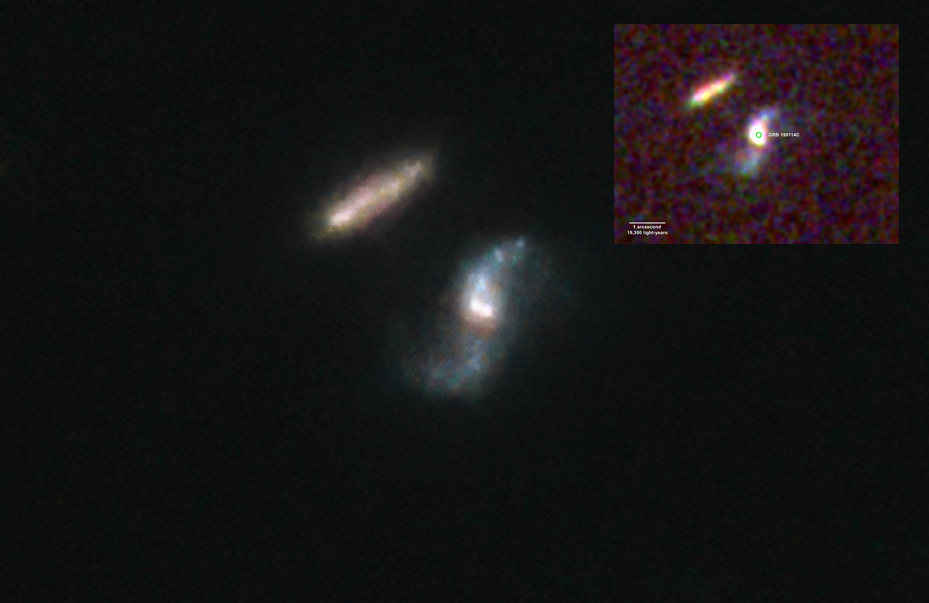Collapsing star breaks the records in very high energy photons production
MAGIC telescopes, on the island of La Palma, detect photons in the range of teraelectronvolts in a gamma ray explosion (GRB), the product of the death of a very massive star. The detection, which requires contemplating new mechanisms in the energy production of GRBs, provides a fundamental perspective to complete our understanding of these events
Gamma-ray bursts (GRB) are short, sudden and extremely powerful cosmic bursts produced by the collapse of massive stars or by the fusion of neutron stars in distant galaxies. They begin with a very intense initial flash whose duration varies between a fraction of a second and hundreds of seconds, followed by a less bright afterglow in a wide range of wavelengths that fades over time. The first GRB detected by MAGIC telescopes, called GRB 190114C, reveals for the first time the most energetic photons detected in these events.
The photons detected by MAGIC are in the range of teraelectronvolts (TeV), which are a thousand billion times more energetic than those of visible light. Theoretical studies predicted that GRBs were TeV photons producers, and this detection culminates decades of research. "After more than fifty years of the discovery of GRBs, many of its fundamental aspects remain unknown -says Razmik Mirzoyan, spokesperson for the MAGIC collaboration-. The discovery of the GRB 190114C emission in the new TeV window shows that gamma ray bursts are even more powerful than previously thought. The large amount of new data acquired by MAGIC and extensive monitoring observations with different instruments offer valuable clues to unravel some of the unknowns related to the physical processes involved in GRBs".

DETECTION WITH MAGIC TELESCOPES
On January 14, 2019, Swift and Fermi space satellites independently discovered the GRB 190114C. In twenty-two seconds its coordinates in the sky were distributed through an electronic alert to astronomers around the world, including the MAGIC collaboration, which operates two telescopes seventeen meters in diameter located on La Palma.
MAGIC telescopes, which stand out for their quick pointing ability, began observing the GRB only fifty seconds after the start. The analysis of the data obtained during the first tens of seconds made this event the brightest source of photons in the range of teraelectronvolts (TeV). As in the afterglow of the GRBs studied at lower energies, the emission quickly faded over time and half an hour later it had disappeared.
The level of energy detected by MAGIC is well above what synchrotron radiation can provide. This radiation is responsible for the emission observed at lower energies in previous bursts and that is produced by electrons moving at speeds close to that of light in the presence of magnetic fields
These new results suggest that the most probable origin of the emission in teraelectronvolts is the so-called inverse compton process, where a population of photons significantly elevates their energy by colliding with very energetic electrons.
MULTIWAVE OBSERVATIONS: THE ENVIRONMENT OF THE BURST
After careful verification of preliminary data, MAGIC collaboration announced the unequivocal detection of TeV photons to the scientific community, which facilitated an extensive campaign of observations at multiple wavelengths.
Thanks to an abundant set of data, IAA researchers have provided a complete overview of the environment where the GRB was produced. “We have combined data from some of the world's most powerful observatories, such as the Hubble Space Telescope, the Very Large Telescope (VLT) and ALMA -the largest radiotelescope in the world- to explain the radiation observed by MAGIC and to check whether the emission of such energetic photons in this GRB is related to the environment of the star that, when it collapsed, produced the outbreak”, says Antonio de Ugarte Postigo, researcher at the HETH group of the IAA-CSIC that coordinates the study.
This group of researchers could thus determine that the GRB was produced in the central region of a galaxy that is in the process of interacting with another somewhat larger and very close galaxy, a process that triggers intense outbreaks of star formation. Not only is the GRB's host galaxy more massive than usual in these phenomena, but the immediate environment of the collapsing star is also denser than the one that this type of outburst has on average. “We need to study the system in even more detail, but such a dense environment might have been crucial in the production of the ultra-energetic photons detected with MAGIC. We hope to confirm it in the next studies we are working on”, says Christina Thöne, a researcher at the HETH group of the Institute of Astrophysics of Andalusia that participates in the articles published today.
In addition, IAA-CSIC researchers participated in the campaign to monitor the event with the Gran Telescopio Canarias (GTC), on the island of La Palma. "The data in the optical obtained by the GTC hours after the detection allowed us to determine the distance at which the burst occurred, about four thousand five hundred million light years", says Alberto J. Castro Tirado, researcher at the ARAE group of the IAA-CSIC that participated in the observation campaign with GTC and coordinates the BOOTES telescope network, which also obtained images of the event (in particular the only simultaneous image covering the region of the sky from which the high energy emission came from).
The Magic Collaboration et al. " Inverse Compton emission revealed by multi-wavelength observations of a gamma-ray burst”, Nature, 21 November 2019. https://www.nature.com/articles/s41586-019-1754-6
A. de Ugarte et al. “GRB190114C in the nuclear región of an interacting Galaxy. A detailed host analysis using ALMA, HST and VLT”, Astronomy & Astrophysics (Nov 2019).
Instituto de Astrofísica de Andalucía (IAA-CSIC)
Unidad de Divulgación y Comunicación
Silbia López de Lacalle - sll[arroba]iaa.es - 958230676
https://www.iaa.csic.es
https://divulgacion.iaa.csic.es

